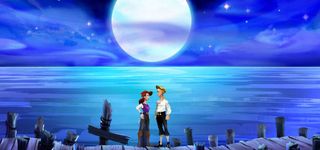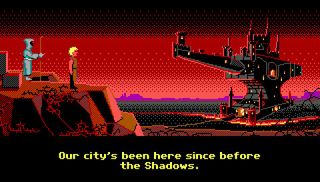
Monkey Island, X-Wing, Day of the Tentacle, Grim Fandango are each worthy of a chapter in the virtual history books. But for every game that LucasArts has released, there were another two or three that never made it onto the shelves. Some of these unfinished works were near-complete productions that almost made it out of the door. Others only ever existed as a few pages of concept outlines, the errant ideas of creative minds. Together, they form a secret history of the studio that, until now, has never been revealed in its entirety.
“When you’re in the moment, you may not realise that what you’re doing has historical value,” says Aric Wilmunder, co-creator of LucasArts’ much-venerated SCUMM engine. Employed at LucasArts from 1984 to 2001, Wilmunder was present during the studio’s golden years. More importantly, he was aware of it, and from time to time would bring home documents and designs in order to safeguard them. “When I saw something, I’d say, ‘God, some day, somebody’s gonna wish we had a copy of that.’”
Over the course of his time there, Wilmunder built up a small archive that charts virtually every LucasArts development during its first two decades in existence. Some items he collected are related to the studio’s best-known games, including the original design binder for Maniac Mansion, “which I don’t think Ron [Gilbert, the game’s co-creator] has seen in 20 years!” Wilmunder laughs. Many more, at a ratio of approximately three to one, are for games that were either partially built or never produced at all.
The vast majority of these unfinished or undeveloped games were bounced around between 1985 and 1995, and the diversity of the ideas is remarkable. Some are typically bizarre LucasArts adventures. I Was a Teenage Lobot was an idea that Wilmunder hatched with Gilbert while the two shared an office in 1985—the year before Maniac Mansion was proposed. The game was to be set on a space station, where the inhabitants discovered that, although creating true AI was impossible, a working robot could be built by lobotomising a person and installing their brain in a metal body. “[Imagine] you find yourself brought in front of a judge and convicted of a crime you didn’t commit,” explains Wilmunder. “And you find yourself—your brain at least—inside the body of this robot.”

In Lobot’s story, the robot in question was a shoe-buffing robot—essentially a shoebox on wheels—and the plot revolved around the player trying to clear their name before their body—held elsewhere on the station—was mulched into dog food. “[The robot] could only say certain things, like, ‘Would you like a shine?’ So your ability to communicate was rather limited, your ability to travel was limited. But you still had this specific time constraint where your goal was to prove your innocence.”
Other concepts are completely removed from LucasArts’ usual fare. In 1989, a design was pitched called Life in the Balance, a wildlife-management game with a topdown view much like SimCity, which was released in the same year. Wilmunder reads from the document: “Assuming the role of a game warden, the player must manage the wildlife in his section of the preserve, protecting them from various threatening elements.” Game mechanics would have involved employing anti-poaching methods and cooperating with local governments to tackle issues such as overpopulation and pollution. Over the years, several management and simulation games were pitched at LucasArts, including a camping simulator entitled Camper and a TV studio-management game named TV Wasteland.
Some of the designs were curiously evocative of enormously successful games made decades later. Another project Wilmunder was involved in, proposed in 1990, was Second Genesis, a space-opera game inspired by TV shows like Mission: Impossible and The A-Team. The player took control of an interstellar task agency “ready to tackle any problem a customer may have”. Wilmunder’s rundown of the game’s structure sounds eerily like Mass Effect: “Infiltration, harsh environments, military ships, alien encounters, puzzles, planets breaking up.”
The biggest gaming news, reviews and hardware deals
Keep up to date with the most important stories and the best deals, as picked by the PC Gamer team.
Most Popular

